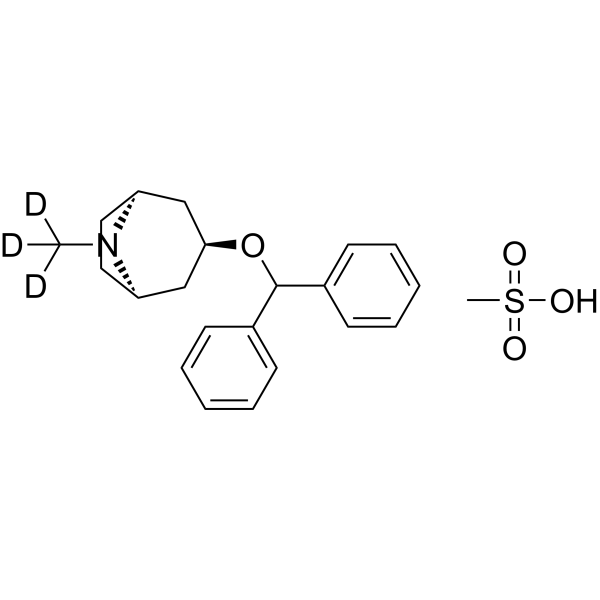Benztropine-d3 mesylate
Modify Date: 2025-08-24 23:11:53

Benztropine-d3 mesylate structure
|
Common Name | Benztropine-d3 mesylate | ||
|---|---|---|---|---|
| CAS Number | 202529-16-6 | Molecular Weight | 406.55 | |
| Density | N/A | Boiling Point | N/A | |
| Molecular Formula | C22H26D3NO4S | Melting Point | N/A | |
| MSDS | N/A | Flash Point | N/A | |
Use of Benztropine-d3 mesylateBenztropine-d3 (mesylate) is the deuterium labeled Benztropine mesylate[1]. Benztropine mesylate (Benzatropine mesylate) is an orally active centrally acting anticholinergic agent that can be used for Parkinson's disease research. Benztropine mesylate is an anti-histamine agent and a dopamine re-uptake inhibitor. Benztropine mesylate is also a human D2 dopamine receptor allosteric antagonist. Benztropine mesylate also has anti-CSCs (cancer stem cells) effects[2][3]. |
| Name | Benztropine-d3 mesylate |
|---|
| Description | Benztropine-d3 (mesylate) is the deuterium labeled Benztropine mesylate[1]. Benztropine mesylate (Benzatropine mesylate) is an orally active centrally acting anticholinergic agent that can be used for Parkinson's disease research. Benztropine mesylate is an anti-histamine agent and a dopamine re-uptake inhibitor. Benztropine mesylate is also a human D2 dopamine receptor allosteric antagonist. Benztropine mesylate also has anti-CSCs (cancer stem cells) effects[2][3]. |
|---|---|
| Related Catalog | |
| In Vitro | Stable heavy isotopes of hydrogen, carbon, and other elements have been incorporated into drug molecules, largely as tracers for quantitation during the drug development process. Deuteration has gained attention because of its potential to affect the pharmacokinetic and metabolic profiles of drugs[1]. |
| References |
| Molecular Formula | C22H26D3NO4S |
|---|---|
| Molecular Weight | 406.55 |
| InChIKey | CPFJLLXFNPCTDW-AJNFSTCNSA-N |
| SMILES | CN1C2CCC1CC(OC(c1ccccc1)c1ccccc1)C2.CS(=O)(=O)O |